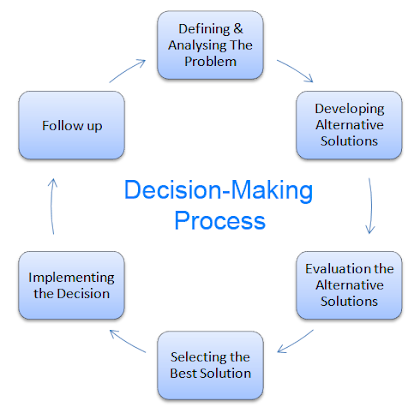Steps in the Decision Making Process of a Manager
 Steps In Decision Making Process
Steps In Decision Making Process
Six steps in the decision making process with diagram are discussed below.
1. Defining and Analysing the real problem
The manager should first find out what is the real problem. The problem may be due to bad relations between management and employees, decrease in sales, increase in cost, etc. After finding out the true problem manager must analyse it carefully. He should find out the cause and effect of the problem.
2. Developing Alternative Solutions
After defining and analysing the real problem, the manager should develop (make) alternative (different) solutions for solving the problem. Only realistic solutions should be considered. Group participation and computers should be used for developing alternative solutions.
3. Evaluating the Alternative Solutions
The manager should carefully evaluate the merits and demerits of each alternative solution. He should compare the cost of each solution. He should compare the risks involved. He should also compare the feasibility of each solution. He should find out which solution will be accepted by the employees.
4. Selecting the best Solution
After evaluating all the solutions, the manager should select the best solution. He should select a solution which is less costly and less risky. He should select a solution which is most feasible and which is accepted by the employees. In short, the manager should select a solution which has the most merits and least demerits. The best solution is called the "Decision".
5. Implementing the Decision
After making the decision, the manager should implement it. That is, he should put the decision into action. He should communicate the decision to the employees. He should persuade the employees to accept the decision. This can be done by involving them in the decision making process. Then the manager should provide the employees with all the resources, which are required for implementing the decision. He should also motivate them to implement the decision.
6. Follow Up
After implementing the decision, the manager must do follow up. That is, he must get the feedback about the decision. He should find out whether the decision was effective or not. This is done by comparing the decision with the action, finding out the deviations (differences) and taking essential steps to remove these deviations. So, follow-up is just like the control function. It helps to improve the quality of future decisions.

Your articles and the way you explain things is just brilliant! Im glad I came here :)
Helped me a lot, Thanks :)